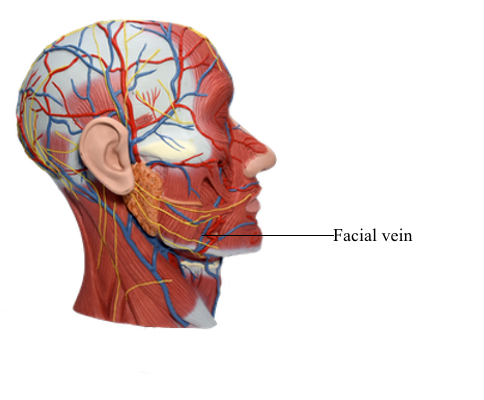Main Model

Blood Vessels : 65 Facial vein

External Veins of Face
Most external facial veins are drained by veins that accompany the arteries of the face. As with most superficial veins, they are subject to many variations. The venous return from the face is normally superficial, but anastomoses with deep veins, a dural sinus, and venous plexus can provide deep drainage for the valveless veins.
Like veins elsewhere, they have abundant anastomoses that allow drainage to occur by alternate routes during periods of temporary compression. The alternate routes include both superficial pathways (via the facial and retromandibular/external jugular veins) and deep drainage (via the anastomoses with the cavernous sinus, pterygoid venous plexus, and the internal jugular vein).
The facial veins, coursing with or parallel to the facial arteries, are valveless veins that provide the primary superficial drainage of the face. Tributaries of the facial vein include the deep facial vein, which drains the pterygoid venous plexus of the infratemporal fossa. Inferior to the margin of the mandible, the facial vein is joined by the anterior (communicating) branch of the retromandibular vein. The facial vein drains directly or indirectly into the internal jugular vein (IJV). At the medial angle of the eye, the facial vein communicates with the superior ophthalmic vein, which drains into the cavernous sinus.
The retromandibular vein is a deep vessel of the face formed by the union of the superficial temporal vein and the maxillary vein, the latter draining the pterygoid venous plexus. The retromandibular vein runs posterior to the ramus of the mandible within the substance of the parotid gland, superficial to the external carotid artery and deep to the facial nerve. As it emerges from the inferior pole of the parotid gland, the retromandibular vein divides into an anterior branch that unites with the facial vein and a posterior branch that joins the posterior auricular vein inferior to the parotid gland to form the external jugular vein. This vein passes inferiorly and superficially in the neck to empty into the subclavian vein.
Facial vein
Origin: Continuation of angular vein past inferior margin of orbit
Course: Descends along lateral border of nose, receiving external nasal and inferior palpebral veins; then passes obliquely across face to cross inferior border of mandible; receives communication from retromandibular vein (after which, it is sometimes called common facial vein)
Termination: Internal jugular vein opposite or inferior to level of hyoid bone
Area Drained: Anterior scalp and forehead; eyelids; external nose; anterior cheek; lips; chin; and submandibular gland